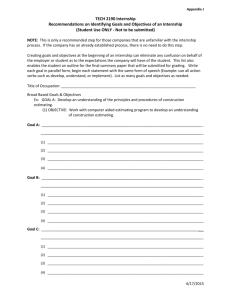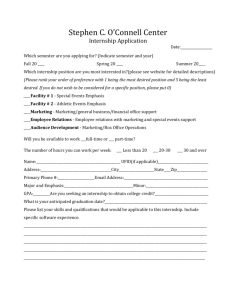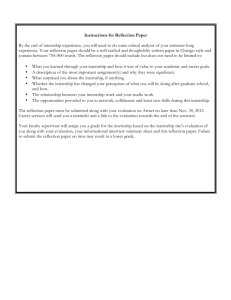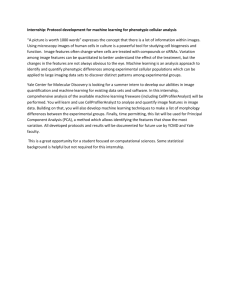Internship Oral Presentation Guidelines
advertisement
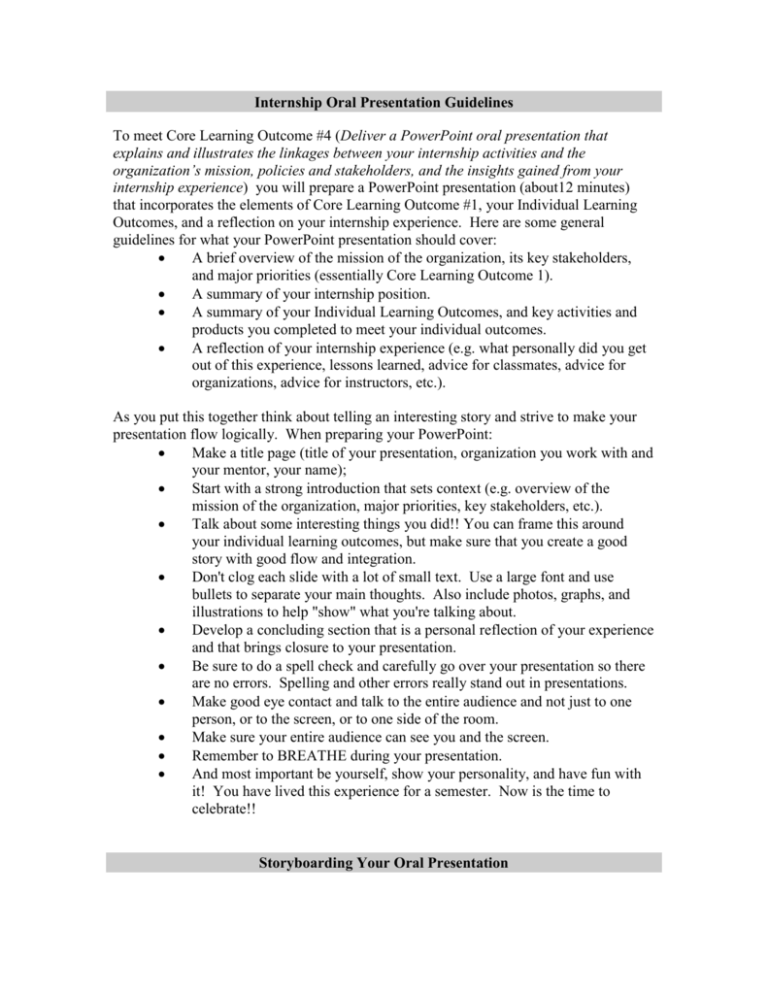
Internship Oral Presentation Guidelines To meet Core Learning Outcome #4 (Deliver a PowerPoint oral presentation that explains and illustrates the linkages between your internship activities and the organization’s mission, policies and stakeholders, and the insights gained from your internship experience) you will prepare a PowerPoint presentation (about12 minutes) that incorporates the elements of Core Learning Outcome #1, your Individual Learning Outcomes, and a reflection on your internship experience. Here are some general guidelines for what your PowerPoint presentation should cover: A brief overview of the mission of the organization, its key stakeholders, and major priorities (essentially Core Learning Outcome 1). A summary of your internship position. A summary of your Individual Learning Outcomes, and key activities and products you completed to meet your individual outcomes. A reflection of your internship experience (e.g. what personally did you get out of this experience, lessons learned, advice for classmates, advice for organizations, advice for instructors, etc.). As you put this together think about telling an interesting story and strive to make your presentation flow logically. When preparing your PowerPoint: Make a title page (title of your presentation, organization you work with and your mentor, your name); Start with a strong introduction that sets context (e.g. overview of the mission of the organization, major priorities, key stakeholders, etc.). Talk about some interesting things you did!! You can frame this around your individual learning outcomes, but make sure that you create a good story with good flow and integration. Don't clog each slide with a lot of small text. Use a large font and use bullets to separate your main thoughts. Also include photos, graphs, and illustrations to help "show" what you're talking about. Develop a concluding section that is a personal reflection of your experience and that brings closure to your presentation. Be sure to do a spell check and carefully go over your presentation so there are no errors. Spelling and other errors really stand out in presentations. Make good eye contact and talk to the entire audience and not just to one person, or to the screen, or to one side of the room. Make sure your entire audience can see you and the screen. Remember to BREATHE during your presentation. And most important be yourself, show your personality, and have fun with it! You have lived this experience for a semester. Now is the time to celebrate!! Storyboarding Your Oral Presentation A storyboard is a visual script (or a guide, plan, or blueprint) for your presentation. It translates your ideas into written and visual images. You do this by providing both a written description and a visual description of each slide that you will develop for your presentation. A storyboard: lets you work out and discuss your ideas. helps you visualize how your story will look. is a step-by-step sequence of how your story is put together. For this exercise I would like you to brainstorm what slides in a 12-minute presentation might look like—both in content and in form. Launch PowerPoint and go into Slide Sorter view. Create about 12-15 blank slides (assuming you spend ~1 minute on each slide). Draft what each slide should look like - not the exact wording, but think about what key information you may want to convey and the types of visuals (e.g. photos, graphs, etc.) that might illustrate the main point of the slide. Written information should only have crisp, clean talking points: limit what you write so the audience can spend more time listening and watching. So spare us the details and save the presentation! You may have some clear ideas about some slides and only vague ideas about others. That’s o.k. - just list concepts for now if that’s all you’ve got. But begin to develop a sense of how you want to develop your story and the order in which you want to present information. Don’t be afraid to move slides around in Slide Sort view if you see a more logical order, or to revise (or even discard) your slides as you start putting the whole story together. Have fun with this. You can always save alternative forms of your slides as, e.g., “Talk1”, “Talk2,” etc. It will not only begin to give you some idea of what you have, but may also help you identify what gaps you need to fill. When you have completed your storyboard, your classmates will review your ideas, ask questions and make suggestions on how to fine-tune your presentation.


